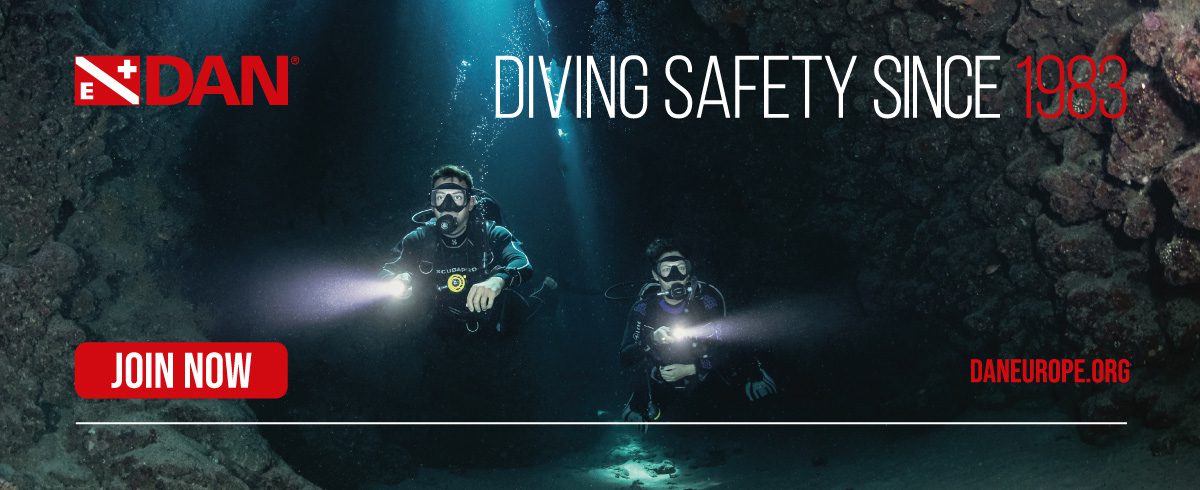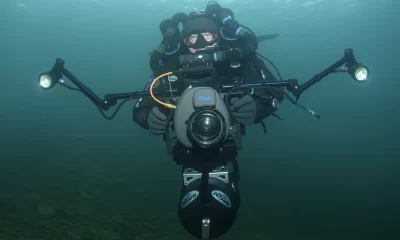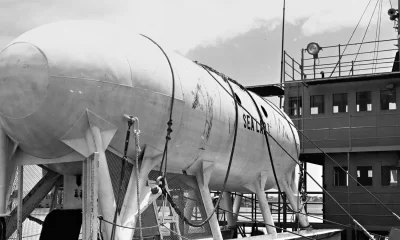Equipment
A Brief History Of Sidemount
From sumping through Wookey with a pair of repurposed WWII Bomber O2 tanks filled with air, to wearing sidemount bailout rebreathers and conducting lengthy sub-100 meter cave penetrations (and, of course, the “Reccies” making holiday sidemount dives in Bonaire), it’s fair to say that sidemount diving has come a long way over the last half a century. Here is a brief history supplemented by talks by Lamar Hires, Bill Rennaker, and Patrick Widmann. Grab two singles and dive in.
Adapted from Wikipedia and YouTube resources by InDEPTH. Special thanks to Michael Thomas for the historical CDG images.

The Beginning: UK Sump Diving
The idea of mounting cylinders on the diver’s chest and sides, originated from cave diving in the UK, during the 1960’s. During the original explorations of Wookey Hole, or other cave systems, explorers encountered submerged passages (sumps) that created an obstacle for further exploration. To bypass these sumps, they started bringing basic scuba equipment specifically to progress beyond the -mostly short and shallow- submerged areas. However, because these caves were mostly very confined spaces, and also because most of their exploration was primarily through the dry parts of these cave systems, their original needs were met with great success using small, minimalist configurations, which reduced bulk and weight that needed to be carried along.

This early implementation of sidemount allowed cylinders to be easily transported individually, but also easily removed and replaced, therefore allowing these explorers to retain the ability to squeeze through the tightest restrictions. The remoteness of these submerged areas, and the nature of these dives -done often in very silty sumps- did not call for the need of perfect buoyancy control or efficient propulsion techniques. Only the minimum needed equipment was carried. A mask, cylinder, regulator, method of attaching the cylinder to the body and on rare occasions a set of fins. Some of these early explorers started using a sturdy belt, with attached cam-band. That made it possible for a cylinder to be carried alongside the side of their body. With this system they could walk or even crawl through the dry cave sections, preserving a reliable and safe method of cylinder attachment when dealing with the submerged areas. Trim efficiency, reduced water resistance and buoyancy control were not taken into much consideration due to the morphology of those systems. This approach to the sump kind of cave exploration was generally called the English System at the time.
The Evolution (1970’s, Florida)
During the 1970’s the original English system was adopted by American based cave explorers, primarily in Florida.The Florida caves were mostly flooded systems and involved prolonged diving, thus more focus was needed to be paid towards developing the diving performance of the system, in particular buoyancy and trim. Divers required proper buoyancy control devices for extended time therefore moving the cylinders from the thigh, up towards the armpit. These explorers were the original cave divers as we know today. They started making their own home-made gear. Modifying off-the-shelf diving equipment, and creating new configurations from scratch. Most of their creations were using webbing harnesses and improvised bladders for buoyancy.

The First Commercial Rig (1990’s)
In the mid-1990’s Lamar Hires designed the first commercial side mount diving system which was then manufactured by Dive Rite. It focused on the newly released Transpac harness. Even with a “proper” option available in the market, many cave divers continued to manufacture their own DIY configurations. At this time, the use of sidemount was used only by a small number of exploration-grade cave divers.

Cave Diving Becomes Popular and with it So Does Sidemount (2000’s)
Brett Hemphill and Curt Bowen, publisher of Advanced Diver Magazine, designed the Armadillo Sidemount harness in 2001. This innovative system brought several new features that would be used in many future sidemount designs. To name a few: BCD inflation was now located at the bottom of the harness instead of the top, butt-anchoring rear attachment pad, cylinder bungee attachment, bungee straps used for faster location of primary bungee. The widespread popularity of sidemount did not truly emerge until the mid-2010s though, when a parallel growing popularity of technical and cave diving started seeing the benefits of what it could offer. Spreading mouth to mouth but also for the first time because of the internet, sidemount was offering an alternative approach that mimicked a Hogarthian minimalism and functionality style, but with the added advantage of comfort, trim control and even if it was not accepted by everyone as a valid argument at the time, safety.
But there was no way to stop the wave that was coming, and was coming hard towards the calm diving waters. An unstoppable increase in interest for sidemount diving “motivated” many manufacturers -and some brilliant individuals- to design and sell their own versions of sidemount systems. OMS, Hollis and UTD developed equipment, while Steve Bogaerts released the incredibly popular, minimalist Razor system which became an instant game changer. With Razor we also saw for the first time, training aimed at a specific diving rig.

The Rise of Sidemount Closed Circuit Rebreathers (CCR) (2010’s – today)
Even if Sidemount was not anymore a cave-only strict configuration, a great deal of it was still used primarily in overhead diving (cave and -more recently- mine diving). It was no surprise that after having found a solution with it to push through restrictions along the way, cave divers now needed the gas to reach further. The time for sidemount rebreathers had come. Initially faced with issues of breathing resistance, among others, CCR manufacturers started developing multiple units. The most popular design consisted of a unit worn on one side of the diver with the diluent on the opposite side. But competition brought innovation, and today we have a variety of different configuration options when it comes to Sidemount CCR. Divesoft introduced the Liberty Sidemount version, a fully autonomous unit, just slightly longer than an s80 cylinder, that includes diluent and oxygen cylinders in one compact design loaded with tech. KISS, after the success of the Sidekick, revolutionized design with the Sidewinder, the first unit that was worn “on top” of a complete Open Circuit Sidemount configuration, adding the benefits of CCR to it. And the list goes on.

YouTube: Lamar Hires – The History of Sidemount Diving (2017)
Lamar Hires of Dive Rite is considered to be one of the pioneers of sidemount diving. In this hour-long presentation, Lamar talks about the history of sidemount, how it came to be, and its evolution over the past two decades.
YouTube: Sidemount and Cave Diving History with Bill Rennaker and Lamar Hires (2018)
On October 27nd, 2018, Bill Rennaker and Lamar Hires were kind enough to talk to a group of cave divers at NFSA event and speak about the history behind sidemount diving and cave diving. The purpose of this video is to catalog and preserve the history of these prominent explorers. Part 2 will be posted soon.
YouTube: Sidemount History From The POV Of Patrick Widmann (2020)
Patrick talks about the history of the Sidemount Diving and shares his experiences which ultimately lead to the creation of the xDeep Stealth 2.0.
Please take a minute and complete our new: Sidemount Diving Survey. We will report the results in a coming issue.
DIVE DEEPER
Outside Magazine: Deeper by Bucky McMahon. To the peerless Moles, practitioners of the gloomily claustrophobic sport of freshwater spelunking, the ultimate accomplishment is finding a virgin cave (1996)
Adrex.com: Sidemount – History of the Diving Equipment Configuration
Advanced Diver Magazine: Armadillo Sidemount Rig (2002) by Brett Hemphill
Wikipedia: Sidemount Diving

















































